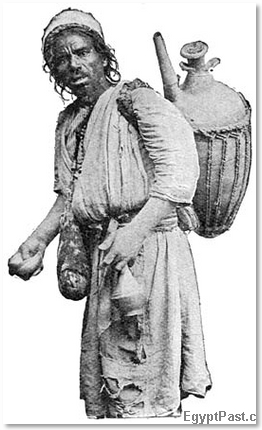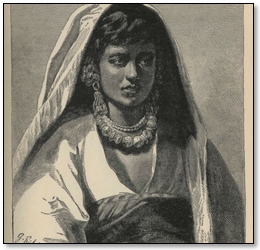Egyptian Clothing

A Poor Egyptian Peasant
Our knowledge of what the Egyptians wore is derived mainly from drawings on tomb walls, as well as finding preserved remains of Egyptian clothing. As in modern society Egyptian fashion changed over time and so different styles of clothing were worn at different times during the development of ancient egyptian civiilization.
There is a constant development observable in the dress of the upper classes. Royalty set the fashions, and they were followed at intervals by those standing on the various social levels. There was a distinction between king and noble and between noble and plebeian. The simple apron bound about the loins was always the essential garment. To this the king added a lion's tail and the noble a panther's skin during the period of the Old Kingdom.
In that of the Middle Kingdom the apron took a pointed triangular shape in front and became longer. Next comes a double apron, a short one beneath, opaque, and a long and transparent one outside. The priest continued to wear the short apron, however, while the king had advanced to a mode of dress which covered the whole body, and was complex in arrangement and structure. That which before was holiday attire became the garb of every day.

An Egyptian Woman
The dress of women was more uniform. It consisted at first of a close-fitting garment which extended from the breasts to the ankles, and was fastened by straps over the shoulders. Only in the latest periods were sleeved or sleeveless mantles worn. Transparent cloth was used for female wear, as for the outer apron of males, but without the inner garment. The dress of peasants consisted simply of the apron, which in some cases amounted only to a band with pendant ends. These simple articles were made of papyrus mats, leather or cloth. The hair was worn short, but the shaving of the head does not appear to have been practiced daily. Wigs of various forms and sizes were used as ceremonial head-coveringss Specimens of them are not infrequent. Natural beards were not worn except by shepherds and similar persons, but an artificial "imperial" beard was one of the marks of royalty and divinity in the tomb representations. Sandals of various sorts completed the costume.
pyramids Egypt Mummies Search Engines Link Report
Egyptian Cities | Egyptian Education | Ancient Egypt | egyptian clothing | Egyptian Houses | The Egyptians | Egyptian Family Life | Egypt and its Neighbours | Government in Ancient Egypt | Egyptian History | Military | Organization of Ancient Egypt | Recreation | Egyptian Religion | Pyramids | About | Privacy Policy | Site News | Site Map
EgyptPast.com - Facts and Information About the History of Ancient Egypt
-